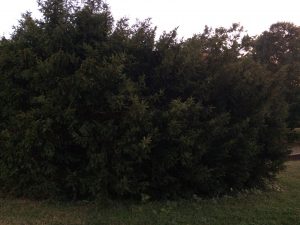
Blog Post 3
14 October 2019; 17:56 – 19:00
Tree Identified: English Yew (Taxus baccata)
This was more fun than I thought it would be. When I first read the instructions I had no ideas what to do, I couldn’t think of a species that I knew would be there but couldn’t identify, until I realized that it didn’t have to be a animal, but that plants and trees count as an organism (duh!). After that it was easy to choose my organism, a nearby tree/bush that I sat right next to that I didn’t know and had incorrectly guessed that it was a species of pine tree. However, it ended up being an English Yew (not even close to a pine). I choose this organism because it seemed right on the ‘tip of my tongue,’ like I should know the species, but just couldn’t put a finger on it. After discovering that it was a yew, it seemed obvious to me.
I found the species of tree by using interactive tree identification websites and apps before getting to one (an app – plant snap) that worked. After a battery of questions, it narrowed down that the most likely tree species was a yew.
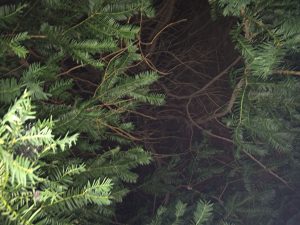
I then googled it and decided and confirmed that it is an English Yew. It was a little hard to identify it, I went through several different searches and had to restart more than once. However, I found it to be fun, discovering the answer through answering a bunch of questions, which required some level of knowledge or intuit about trees.
The observations I made about the organism really helped with answering the questions necessary in narrowing down on the species. The first thing I looked at was the size of the organism. At first I thought it was all one organism, but I realized that the tree was actually trees, but the branches of the different trees had all overlapped one another, giving the illusion that they were all one hedge instead of multiple smaller trees. The branches had dark green and flat needles, ~1-4 cm in length, arranged on the stem in a ‘v’ with two flat sides.
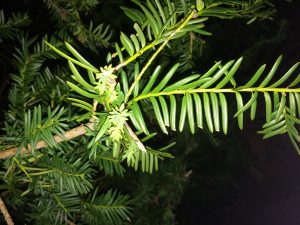
The inner ‘v’ shape was dark green, with the outer side being a lighter green, and the
stem attached to it being the same light green. The light green side has a dark green line through it. The needles felt almost plastic-y, and where brushed or forcefully arranged, they sprang right back into shape. On the stem there were also 5-6 buds that looked like the beginning of berries, as they were in the same position as the mature berries. The next observation I made was about the red berries I kept seeing, they were firm and looked waxy, but were thoroughly red, with no other color, although the red faded at the bottom. On the bottom there is also a hollow point. After the time was up I then went and researched it.
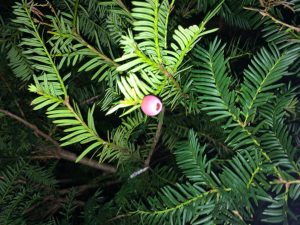
English Yews are incredible, with so many amazing things about it! First of all, the berries? NOT BERRIES! They’re arils, which is its seed but in a fleshy, red skin.
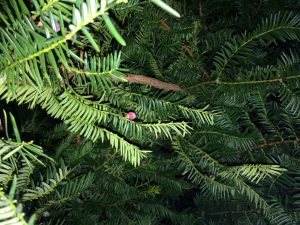
Also, the trees can grow to over 100 ft which was super surprising because the ones I was observing were 7-8 feet tall, and from my memories, they haven’t grown much since my first year. And the needles… POISONOUS! (I’m glad I decided not to lick it to see if there was a taste).
Yews also live for an incredible long time! On average they live for 400-600 years, with the oldest yew in the world (located in Scotland) is somewhere between 2000 – 5000 years old! (That’s older than some modern civilizations). Fun Fact: Yew trees are only considered ‘ancient’ if they live past 900 years.


Hello!
I am glad you had fun trying to identify your English Yew! When you explained how you had to restart your research multiple times, I felt that I had the same experience. But, even after all the research, it is definitely satisfying when you make the final observation and come to a conclusion for what the organism is.
I also think that it is pretty amazing how old yews can live up to!
Brooke, you’re post was super engaging and actual cool to read! I loved the information about the oldest Yew. I can’t believe that these trees could live so long! What adaptations do you think this plant possesses that allows them to live so long? Very nice post, I love how you took these at night as well.
It seems like you had a lot of fun identifying your organism! Your post are very interesting!